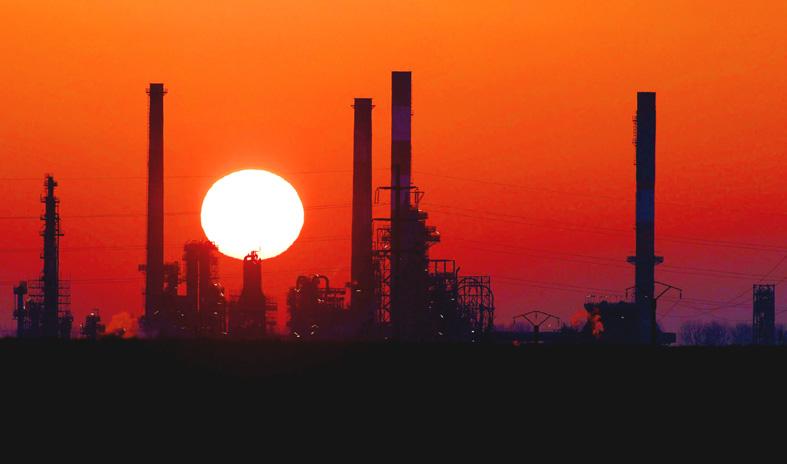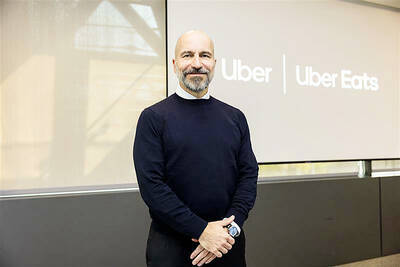A start-up in Iceland is tackling a key piece of the climate change puzzle by turning carbon dioxide into rocks, allowing the greenhouse gas to be stored forever instead of escaping into the atmosphere and trapping heat.
Reykjavik-based Carbfix captures and dissolves carbon dioxide in water, then injects it into the ground where it turns into stone in less than two years.
“This is a technology that can be scaled — it’s cheap and economic and environmentally friendly,” Carbfix chief executive officer Edda Sif Pind Aradottir said in an interview. “Basically we are just doing what nature has been doing for millions of years, so we are helping nature help itself.”

Photo: Reuters
Once considered a pipe dream, capturing and storing carbon dioxide has in the past few years become an area of immense interest for high-profile investors, such as Microsoft Corp cofounder Bill Gates and Tesla Inc chief executive officer Elon Musk, who are searching for solutions to avoid the worst effects of global warming.
The technology can work in two ways. The first is called “carbon capture,” where the gas is trapped from the smokestacks of factories and power plants before it escapes into the atmosphere. A second, more challenging process, is “carbon removal” — withdrawing carbon dioxide from the air around us.
Carbon capture can cut a company or government’s emissions to zero, while carbon removal can help offset its emissions, or even make its impact negative, by taking more carbon dioxide out of the air than it produces.
Carbfix is doing both. It is scaling up its project at the Hellisheidi geothermal power plant to capture carbon emissions as they are released, and it is partnering with Swiss start-up Climeworks AG that builds machines to capture carbon dioxide directly from the air.
While geothermal plants are already classified as renewable energy, they do produce a small fraction of the carbon dioxide that would be generated by a natural gas facility.
When it comes to carbon capture, the Hellisheidi plant can do so at a cheaper cost than buying carbon credits, Aradottir said.
Its process costs about US$25 a tonne, compared with the price of about 40 euros (US$48) a tonne on the EU’s Emissions Trading System, the bloc’s key policy tool to reduce emissions.
Climeworks’ direct air capture operation is much more expensive. On the company’s Web site, individuals can buy offsets that cost more than US$1,200 a tonne. Bulk buyers can get them cheaper.
“I bought out their capacity and I got volume discount,” Gates said in an interview last month. “I think that may be at US$600 [a tonne].”
The Emissions Trading System was created before direct air capture became a viable technology and it does not accept credits for direct air capture.
Yet a growing number of analysts say such offsets would need to become part of the program to ensure that Europe meets its Green Deal objective of becoming carbon neutral by 2050.
That is one reason why Gates and Microsoft are backing projects by Climeworks.
“Climeworks’ direct air capture technology will serve as a key component of our carbon removal efforts,” Microsoft carbon removal manager Elizabeth Willmott said.
Musk last month announced that he would fund a new Carbon Removal Prize that would distribute US$100 million to the best technology innovations over four years.
CarbFix said it is taking part.
Carbfix was born from a research project and founded in 2007 by Reykjavik Energy, the University of Iceland, CNRS in France and the Earth Institute at Columbia University. It is owned by Reykjavik Energy.
The first pilot injections were done in 2012, followed by a full-scale capture plant for two of six high-pressure turbines at the Hellisheidi plant in 2014. The plant’s capture capacity was then doubled in 2016 and the aim is to bring emissions from the plant down to near-zero in the coming years. In 2017, Climeworks installed its direct-air-capture machine at Hellisheidi.
The technology relies on basalts, where the carbonated water reacts with elements such as calcium, magnesium and iron, forming carbonates that fill up empty spaces in the rocks underground. Carbfix is also working with research institutions on making the technology applicable for other types of rock.
The company aims to reach 1 billion tonnes of permanently stored carbon dioxide in 2030.
The global storage potential using the technology is greater than the emissions from burning all fossil fuels on earth, Carbfix said.
Europe could theoretically store at least 4,000 billion tonnes of carbon dioxide in rocks, while the US could store at least 7,500 billion tonnes.
“It will never be the only solution,” Aradottir said. “We are ambitious and have high hopes that we can bring the technology to scale — and there I’m talking about the gigaton scale — and that we’re able to do this quickly because that’s what the world needs.”

CHIP RACE: Three years of overbroad export controls drove foreign competitors to pursue their own AI chips, and ‘cost US taxpayers billions of dollars,’ Nvidia said China has figured out the US strategy for allowing it to buy Nvidia Corp’s H200s and is rejecting the artificial intelligence (AI) chip in favor of domestically developed semiconductors, White House AI adviser David Sacks said, citing news reports. US President Donald Trump on Monday said that he would allow shipments of Nvidia’s H200 chips to China, part of an administration effort backed by Sacks to challenge Chinese tech champions such as Huawei Technologies Co (華為) by bringing US competition to their home market. On Friday, Sacks signaled that he was uncertain about whether that approach would work. “They’re rejecting our chips,” Sacks

NATIONAL SECURITY: Intel’s testing of ACM tools despite US government control ‘highlights egregious gaps in US technology protection policies,’ a former official said Chipmaker Intel Corp has tested chipmaking tools this year from a toolmaker with deep roots in China and two overseas units that were targeted by US sanctions, according to two sources with direct knowledge of the matter. Intel, which fended off calls for its CEO’s resignation from US President Donald Trump in August over his alleged ties to China, got the tools from ACM Research Inc, a Fremont, California-based producer of chipmaking equipment. Two of ACM’s units, based in Shanghai and South Korea, were among a number of firms barred last year from receiving US technology over claims they have

BARRIERS: Gudeng’s chairman said it was unlikely that the US could replicate Taiwan’s science parks in Arizona, given its strict immigration policies and cultural differences Gudeng Precision Industrial Co (家登), which supplies wafer pods to the world’s major semiconductor firms, yesterday said it is in no rush to set up production in the US due to high costs. The company supplies its customers through a warehouse in Arizona jointly operated by TSS Holdings Ltd (德鑫控股), a joint holding of Gudeng and 17 Taiwanese firms in the semiconductor supply chain, including specialty plastic compounds producer Nytex Composites Co (耐特) and automated material handling system supplier Symtek Automation Asia Co (迅得). While the company has long been exploring the feasibility of setting up production in the US to address

OPTION: Uber said it could provide higher pay for batch trips, if incentives for batching is not removed entirely, as the latter would force it to pass on the costs to consumers Uber Technologies Inc yesterday warned that proposed restrictions on batching orders and minimum wages could prompt a NT$20 delivery fee increase in Taiwan, as lower efficiency would drive up costs. Uber CEO Dara Khosrowshahi made the remarks yesterday during his visit to Taiwan. He is on a multileg trip to the region, which includes stops in South Korea and Japan. His visit coincided the release last month of the Ministry of Labor’s draft bill on the delivery sector, which aims to safeguard delivery workers’ rights and improve their welfare. The ministry set the minimum pay for local food delivery drivers at